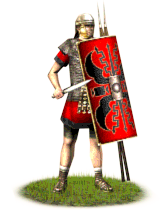Early Legionary First Cohort (RTW Unit)
![]() The first cohort consists of well-armed and armoured infantrymen, who go into combat carrying a Legionary Eagle, an inspirational symbol for other Roman troops.
The first cohort consists of well-armed and armoured infantrymen, who go into combat carrying a Legionary Eagle, an inspirational symbol for other Roman troops.
Overview
The Roman first cohort consist of well-armed and armoured infantrymen, who go into combat carrying the symbol of Roman power, a Legionary Eagle. This is inspirational for other Roman troops. Legionaries are tough, professional troops with good armour and superb weapons. Their hallmarks are discipline, obedience and tactical flexibility. When approaching enemy fortifications, for example, they can use the turtle formation, or testudo, overlapping their shields for protection.
Every legionary’s chainmail armour, the lorica hamata, is of very good quality, as is the rest of his gear: a metal helmet and a large curved shield. They fight with two throwing spears (the pilum, plural pila) and a short stabbing sword, the gladius. Each pilum has a soft iron shaft behind the piercing head that is designed to bend as soon as it hits a target, making it impossible to pull out and throw back. Embedded in a shield a pilum hampers an enemy. Embedded in a man, it usually kills. Once the pila have been thrown, the first cohort close and continue fighting with the stabbing gladius.
Historically, these cohorts came to be after the army reforms of Gaius Marius. He made the Roman army into a professional force. Men served a term of 25 years and then retired with enough land to give them pensions for the remainder of their days. The best legionaries in each legion would naturally gravitate through seniority into the first cohort.
Details
The Early Legionary First Cohort shares many similarities to the Early Legionary Cohorts and are used in the same ways, but with a few important advantages.
The most visible difference is that Early Legionary First Cohorts have 50% more non-officers and an additional officer in the ranks. That officer holds the “Aquila”, a Roman standard representing the legion’s honor and prestige. This banner acts as an inspiring symbol to units around it, giving bonuses to nearby units of their army.
Because of these distinctions, Early Legionary First Cohorts are more expensive than Early Legionary Cohorts – almost two-thirds higher recruitment cost and nearly fifty percent more upkeep. These more elite units are also recruited at an Army Barracks, while Early Legionary Cohorts only need a City Barracks.
